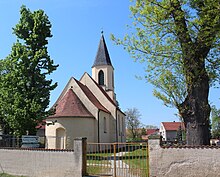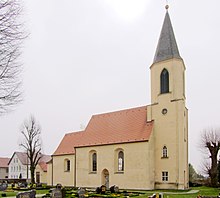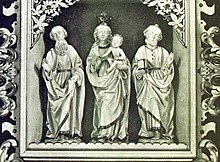Shrub village church
The village church Strauch is a listed church building in Strauch , a district of the city of Großenhain in the Saxon district of Meißen .
The Romanesque style church can be found in the center of the village with an adjoining cemetery .
history
Little is known about the older history of the Stubs village church. There is evidence that a church already existed in Strauch in 1495. At first there was only the small apse in the east of the building visible today, together with a small chapel. In 1567 the small church was enlarged and the current nave was built.
Originally this church belonged to the parish Frauenhain . From 1575 it became a branch church of Hirschfeld and finally independent in 1594.
In 1846 the church was extensively repaired. In 1864 the tower in the west of the nave was built. At the same time new bells were procured. Until then, the bells hung in a wooden tower at the entrance to the church. The Großenhain master builder JC Müller was responsible for the plans for the tower .
Extensive renovation work on the church took place in 1915. The Strauch Church has been a branch church of Skäßchen since 1931 . It was renovated from 1997 to 2000. Since the end of 1998 it has been used for church occasions and events again.
Building description
Built in the Romanesque style church shrubs consists of several parts: the one Karner similar apse, today's altar area and a 1763 built with high arched windows provided nave. In the west of the ship there is a square tower with an octagonal bell storey and a pointed helmet.
Furnishing
The interior of the church is flat, as is the choir. The apse, however, is vaulted.
The Gothic Marian altar of the church, in front of which there is a small crypt in the floor, dates from the 16th century. The church is also equipped with an altar shrine from the 19th century. In this there are three late Gothic carved figures, which represent Mary with child between Peter and Paul. The figures were created around 1500. Another carved figure from the second half of the 18th century can be found on the choir wall.
The inventory of the church also includes an oak chest from the 13th century and the death shield of Adam von Köckritz († 1699).
organ
The organ in the church today dates from 1962. The instrument was created in the workshop of the Dresden organ building company Jehmlich and is located on the only gallery . The organ has seven registers on a manual and pedal with mechanical slider chests .
The disposition is as follows:
|
|
||||||||||||||||||||
- Coupling : I / P
Peal
The ringing consists of three chilled cast iron bells. The belfry consists of a wooden structure. Below is a data overview of the bell:
| No. | Casting date | Caster | diameter | Dimensions | Chime |
|---|---|---|---|---|---|
| 1 | 1954 | Bell foundry Schilling & Lattermann | 1080 mm | 530 kg | b ′ |
| 2 | 1954 | Bell foundry Schilling & Lattermann | 843 mm | 250 kg | d ″ |
| 3 | 1954 | Bell foundry Schilling & Lattermann | 700 mm | 130 kg | f ″ |
Dunning and remembrance
Since 1953, bronze plaques with engraved names can be found in the chancel of the church . These commemorate the villagers of the Strauch community who died in World War I and World War II .
Literature (selection)
- The Grossenhain, Radeberg and Bischofswerda inspections . tape 7 . Schmidt, Dresden 1841, p. 146 - 148 ( digitized version ).
- Cornelius Gurlitt : Official Authority Grossenhain (Land) . Dresden 1914, p. 392-398 .
- Luise Grundmann, Dietrich Hanspach: The Schraden. A regional study in the Elsterwerda, Lauchhammer, Hirschfeld and Ortrand area . Ed .: Institute for Regional Geography Leipzig and the Saxon Academy of Sciences in Leipzig. Böhlau Verlag, Cologne / Weimar / Vienna 2005, ISBN 3-412-10900-2 , p. 187-190 .
- Rainer Thümmel: Bells in Saxony. Sound between heaven and earth. Edited by the Evangelical Regional Church Office of Saxony . With a foreword by Jochen Bohl and photographs by Klaus-Peter Meißner. 2nd, updated and supplemented edition. Evangelische Verlagsanstalt, Leipzig 2015, ISBN 978-3-374-02871-9 , p. 362.
Web links
- The Strauch village church on the homepage of the church district Meißen-Großenhain
- Data sheet of the Strauch Jehmlich organ on the homepage of the church district Meißen-Großenhain (PDF file)
Notes and individual references
- ↑ List of monuments of the State of Saxony , accessed on September 22, 2017.
- ↑ a b c d e The Stubs village church on the homepage of the church district Meißen-Großenhain , accessed on September 22, 2017.
- ↑ a b c d Cornelius Gurlitt: Amtshauptmannschaft Grossenhain (country) . Dresden 1914, p. 392-398 .
- ↑ a b c d Luise Grundmann, Dietrich Hanspach: Der Schraden. A regional study in the Elsterwerda, Lauchhammer, Hirschfeld and Ortrand area . Ed .: Institute for Regional Geography Leipzig and the Saxon Academy of Sciences in Leipzig. Böhlau Verlag, Cologne / Weimar / Vienna 2005, ISBN 3-412-10900-2 , p. 187-190 .
- ↑ Strauch entry in the Digital Historical Directory of Saxony , accessed on September 24, 2017.
- ↑ a b The Grossenhain, Radeberg and Bischofswerda inspections . tape 7 . Schmidt, Dresden 1841, p. 146 ( digitized version ).
- ↑ a b c Georg Dehio: Handbook of German art monuments - Saxony I . 2nd Edition. 1996, ISBN 978-3-422-03043-5 , pp. 814 .
- ↑ a b data sheet of the Strauch Jehmlich organ (PDF file) on the homepage of the church district Meißen-Großenhain, accessed on September 24, 2017.
- ↑ a b Rainer Thümmel : Bells in Saxony: Sound between heaven and earth . Evangelische Verlagsanstalt, Leipzig 2011, ISBN 978-3-374-02871-9 , pp. 362 .
- ↑ Online project Memorial Memorials , accessed on September 24, 2017
Coordinates: 51 ° 21 ′ 57.7 " N , 13 ° 34 ′ 20.6" E





